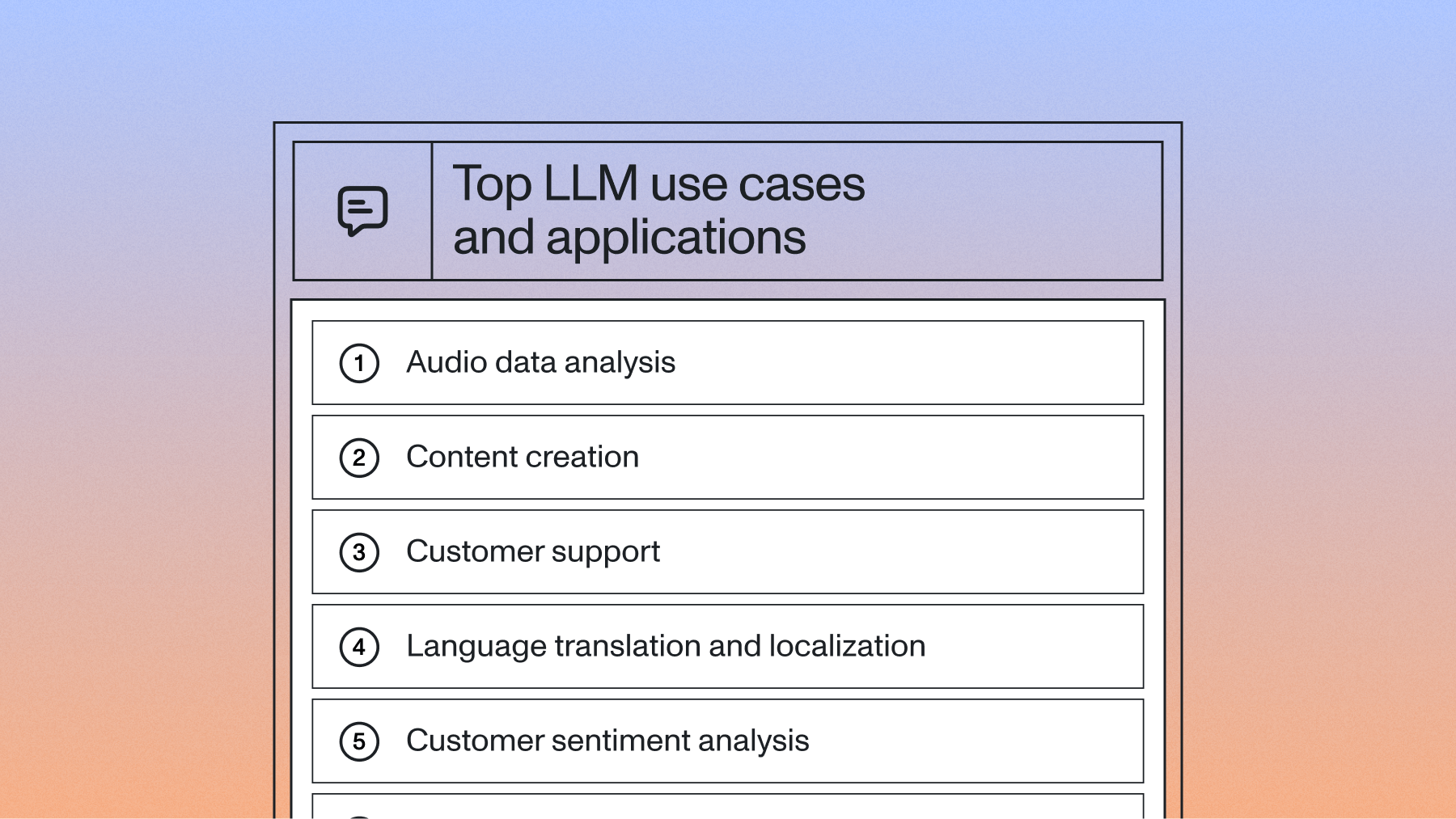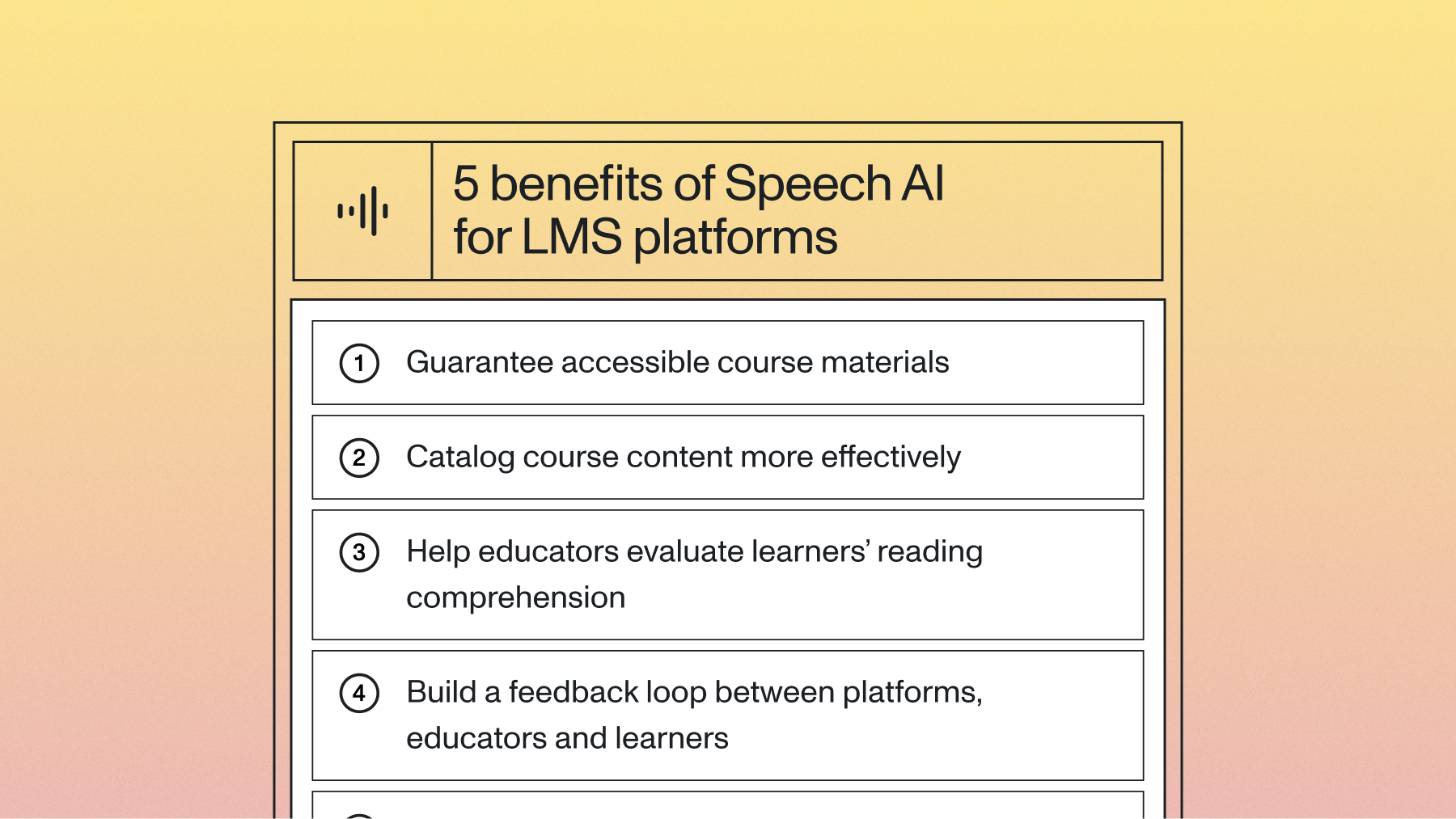Should I build or buy an AI speech recognition system?
In this article, we’ll look at what exactly an AI speech recognition system is and some of the strongest use cases for AI speech recognition before examining the top considerations when deciding whether to build or buy.



With the abundance of AI models and systems now available, many companies are incorporating AI into their product roadmap.
Your team may be leveraging AI speech recognition models that automatically process voice data (such as phone calls, virtual meetings, podcasts, etc.) into readable transcripts, which is a logical first step for companies with enormous amounts of audio and video data. Or, you may be going a step further and adding additional AI models on top of this transcription data to extract insights from your data. These additional models perform intelligent data analysis such as Summarization, Sentiment Analysis, Topic Detection, and more.
But if your team is still evaluating the best AI solution for your needs, you may be wondering: should we buy a pre-existing AI speech recognition model, or should we try to build and maintain an AI speech recognition model internally?
In this article, we’ll look at what exactly an AI speech recognition system is and some of the strongest use cases for AI speech recognition before examining the top considerations when deciding whether to build or buy.
What is AI speech recognition?
AI speech recognition refers to Automatic Speech Recognition (ASR) models that transcribe and process human speech into readable text. Built with cutting-edge AI research, ASR models can transcribe audio and video files both asynchronously, after a file has been recorded, or synchronously with the aid of a real-time ASR model.
Today’s ASR models like Universal-1 are trained on massive datasets to achieve near-human levels of accuracy.
ASR models also serve as a crucial building block for product teams looking to incorporate additional Speech AI models and frameworks that perform sophisticated analysis of these transcribed texts. These can include:
- Audio Intelligence: Audio Intelligence models help users unlock additional information from spoken data and can include models like Sentiment Analysis, Summarization, Entity Detection, PII Redaction, Content Moderation, and more.
- Large Language Models (LLMs): Large Language Models, or LLMs, let users build Generative AI tools on top of voice data.
- Frameworks for Large Language Models (LLMs): Frameworks for LLMs make working with LLMs easier and faster for most users. For example, LLM gateway can unify an entire AI stack for audio and help users build features like custom summaries, action item generation, questions and answers, and more.
Use cases for AI speech recognition
Use cases for AI speech recognition (also known as Speech AI) are extensive and tap into any industry that captures or processes audio and video data.
Top use cases include:
- Adding subtitles to videos and virtual meetings to increase accessibility and compliance
- Automatically summarizing and analyzing sales and customer calls
- Monitoring customer sentiment over time
- Automatically labeling multiple speakers in an audio or video file
- Quickly detecting and monitoring sensitive content, such as hate speech
- Increasing searchability of online video content through AI-generated summaries and key phrase identification
- Automatically scoring and categorizing key sections of sales and customer calls
- Coaching agents and representatives based on best practices
Read AI speech recognition customer stories
Top considerations for building vs. buying an AI speech recognition system
Even if your product team is committed to integrating AI into your roadmap, you may wonder: should we build an AI speech recognition model ourselves, or should we integrate a pre-existing model from an AI partner?
Here, we’ll look at some of the top considerations to discuss, including: accuracy, internal resources, speed of iteration, and security and support.
Accuracy
As you’re deciding whether to build or buy an AI speech recognition system, consider accuracy as a top decision-making factor. While a custom AI model may seem like it would be more accurate, this is rarely the case in the field of ASR and speech recognition. This is mainly because today’s generally available models are trained on massive and diverse datasets and are consistently updated based on the latest AI research—and both are difficult to match with an in-house model.
For example, AssemblyAI’s Universal-1 model is trained on 12.5 million hours of multilingual audio data from a diverse range of datasets.
In addition, the model is maintained by a team of expert AI researchers and engineers with extensive experience in the field. Because of these factors, the model achieves industry-leading accuracy that would be difficult to attain–and maintain–at a company that has to contend with competing priorities.
Do I need a custom speech recognition model?
Internal resources
In addition to accuracy, you should also consider your company’s resources.
More specifically, do you have the internal AI expertise to tackle a complex project like building your own AI speech recognition system? If you decide to build in-house, does your team of developers and engineers have the capacity to work on this? Does your team have deep expertise in AI and speech recognition best practices? If not, sourcing this talent can be difficult given the limited pool of highly qualified talent available.
If your company decides to build in-house, consider how and where to source training data. For the model to be robust against a wide range of accents, vocabularies, background noise, languages, and speakers, the datasets used to train the model must also be large and diverse. Unfortunately, many of the publicly available datasets are academic datasets that do not encompass the diverse audio/video sources likely to be represented in real-world scenarios.
Many teams fail to consider the persistent ongoing maintenance that is required for an in-house model. Is your engineering team equipped to quickly manage any issues customers surface with the models? A small error could result in stalled business operations for end users.
How will you ensure the model is continuously state-of-the-art, given the speed of iteration in the field of AI? How much will it cost to provide this continuous maintenance compared to the cost of a third-party provider?
Evaluating your internal resources and planning accordingly ensures your projects are not abandoned and you don’t see wasted spend.
Speed of iteration
If you're at a fast-growing company, consider the speed of iteration.
If your engineering and development team has split priorities between developing and maintaining a custom AI speech recognition system and designing and building the customer-facing tools and features, will they successfully be able to manage these competing priorities?
Understanding which priorities are the most necessary to tackle in-house versus outsourcing to an AI expert can greatly impact the speed of iteration, time to market, and ultimately, customer satisfaction. In a fast-moving field, this balance can mean the difference between market growth and contraction.
Data security
Finally, consider the data security, privacy, compliance, and ongoing support involved with developing and maintaining a model in-house.
In today’s interconnected world, data privacy and security are top concerns for most companies. If you’re building in-house, decide how to store and manage customer data processed by the speech recognition model. Will the raw data contain sensitive information, such as credit card numbers or medical history? Will any stored data be encrypted? Will any customer data be used to train the model itself, and if so, is this properly disclosed?
Some companies will also have compliance concerns, such as GDPR and HIPAA, that must be adhered to, so make sure you have an internal plan to meet these requirements.
See Also: Speech-to-Text Privacy for APIs
Build or Buy checklist
If you’re considering the pros and cons of building or buying an AI speech recognition system, make sure to investigate the following questions:
- How will you ensure the model achieves and maintains continuous, state-of-the-art accuracy?
- How will the model handle custom vocabulary needs?
- Do you currently have the internal expertise to build an AI model in-house or will you need to hire additional experts?
- Do you have a thorough understanding of AI and speech recognition best practices?
- How will you source diverse, robust training data?
- How will you handle the ongoing maintenance of the model?
- How will you quickly handle mission-critical support requests?
- Do you have a clear understanding of the startup and ongoing costs of building in-house versus partnering with a third party?
- Do you have a plan to manage competing engineering and development priorities?
- How will you ensure data security and compliance?
Lorem ipsum dolor sit amet, consectetur adipiscing elit, sed do eiusmod tempor incididunt ut labore et dolore magna aliqua. Ut enim ad minim veniam, quis nostrud exercitation ullamco laboris nisi ut aliquip ex ea commodo consequat. Duis aute irure dolor in reprehenderit in voluptate velit esse cillum dolore eu fugiat nulla pariatur.




%20is%20Being%20Used%20Today.png)


